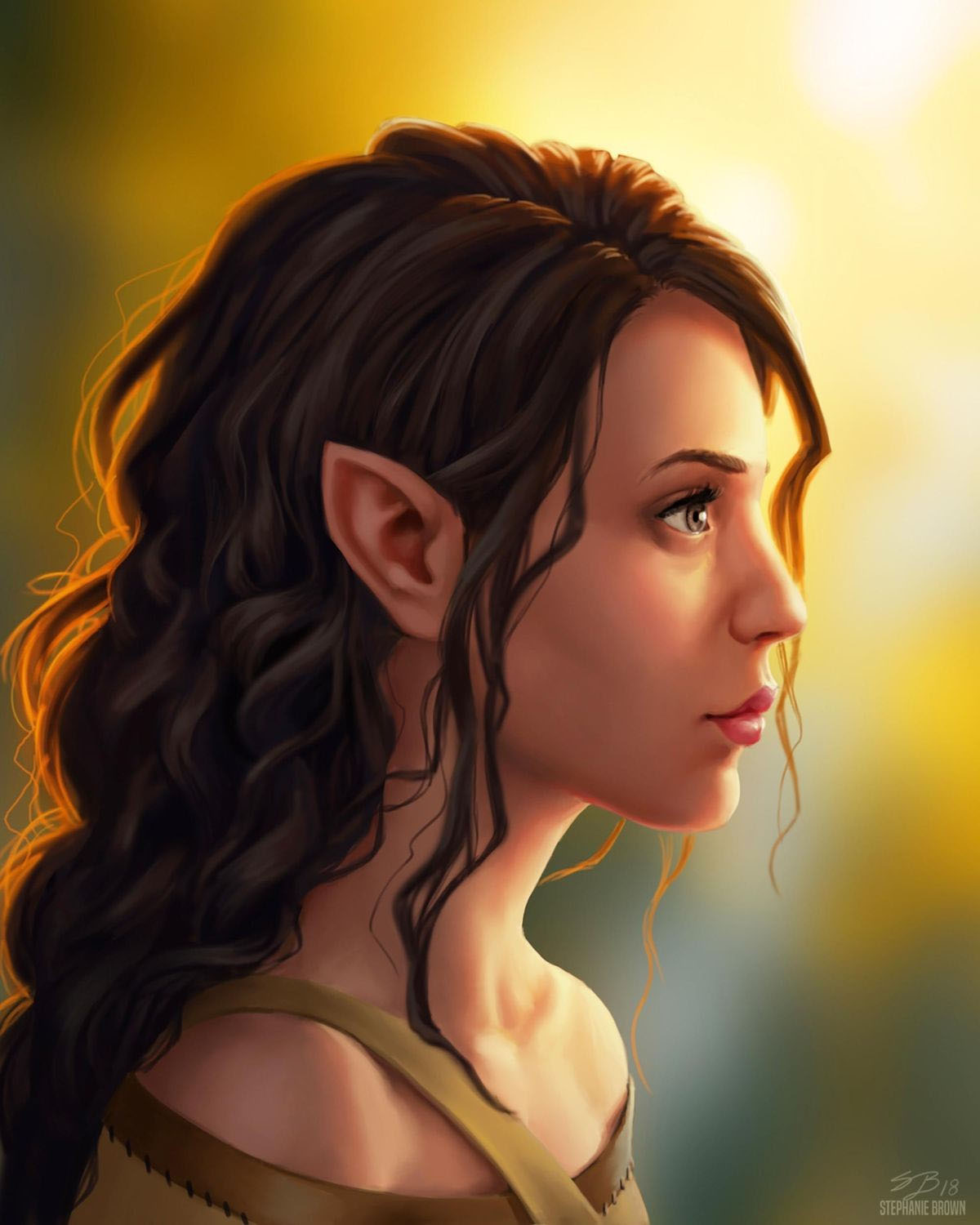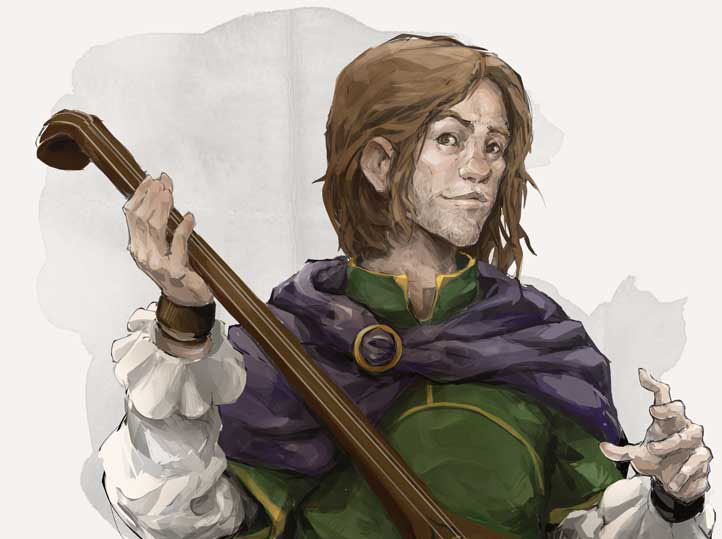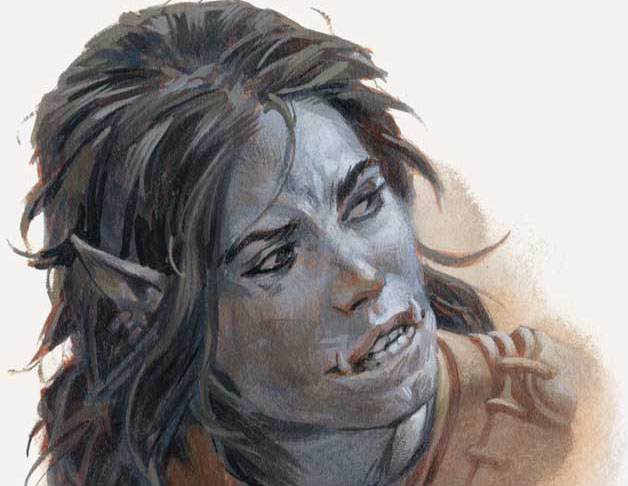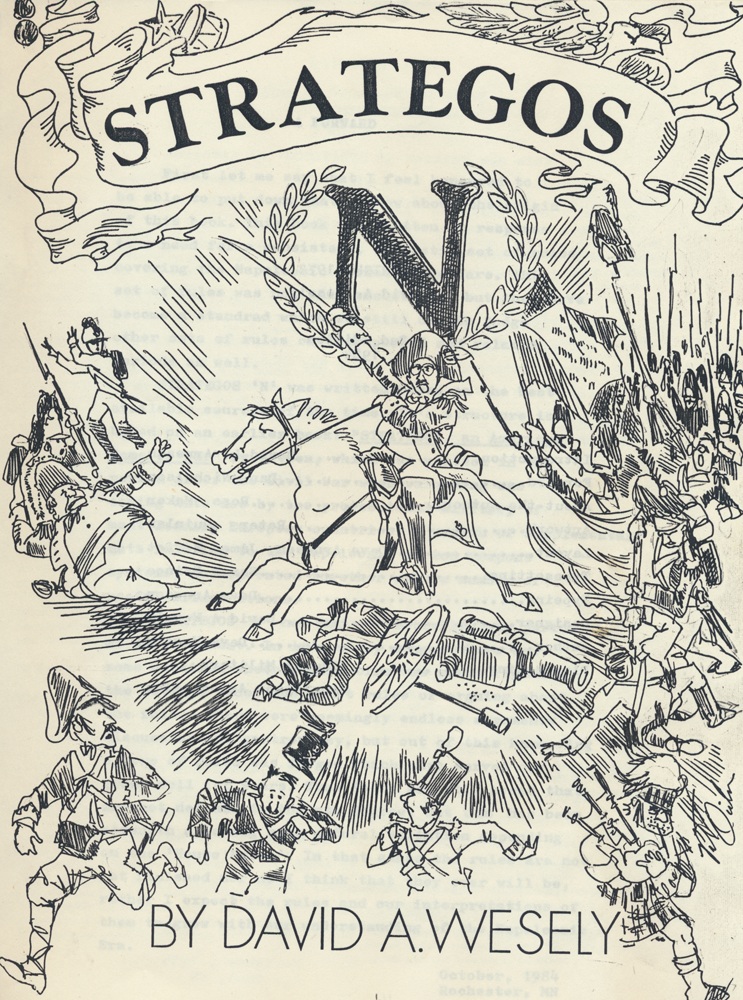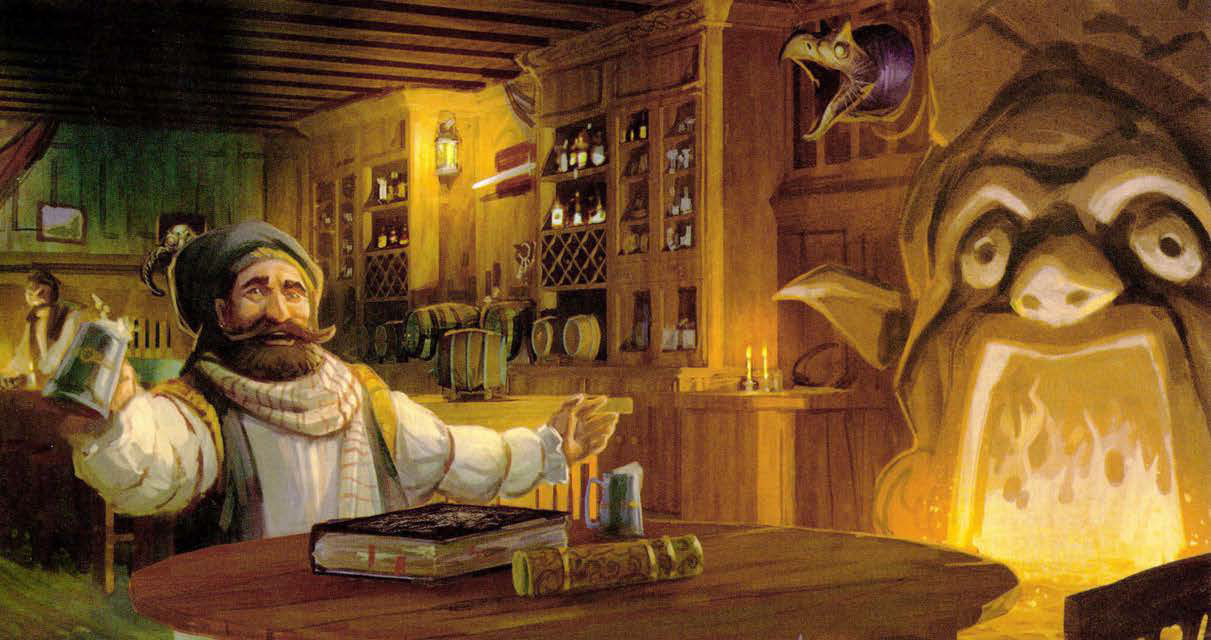TALISOLVANAR “TALLY” FELLBRANCH
Appearance: Half-elf with short brown hair in a simple bowl-cut. Large blue eyes. Wears a leather vest with small tools in its many pockets.
Roleplaying:
- Strong handshake.
- Very sarcastic.
- Rubs the tops of his ears as a nervous habit.
Background:
- Owner and chief artisan of the Bent Nail, located at the eastern end of Trollskull Alley (DH p. 32).
- Brother to Mellannor Fellbranch, the groundskeeper of the Phaulkonmere and representative of the Emerald Enclave (DH p. 35).
Stats: Commoner (MM p. 345)
- Chaotic Good
- Racial Traits: Advantage vs. charmed. Immune to magical sleep. Darkvision to 60 ft.
- Languages: Common, Elvish.
EMBRIC
Appearance: Flaming red skin with fiery red hair that writhes under extreme emotion. Eyes flare red when angry.
Roleplaying:
- Prone to extreme mood swings.
- Hair does a twirling dance (often intermingling with Avi’s) when drunk.
- Voice sounds like crackling flames.
- A faint scent of brimstone when he burps.
Background:
- Married to Avi. Co-owner of Steam and Steel, located at the eastern end of Trollskull Alley (DH p. 32). Tends the forge and is an expert weaponsmith.
- Belongs to the Most Careful Order of Skilled Smiths and Metalforgers.
- Claims descent from the efreet of Calimshan.
Stats: Bandit Captain (MM p. 344)
- Neutral Good
- Racial Traits: Cast produce flame at will (Constitution spellcasting ability, +4 bonus to hit with spells). Darkvision 60 ft. Resistance to fire.
- Languages: Common, Primordial
AVI
Appearance: Blue skin with beads of moisture twinkling upon it, with large, blue-black eyes. Smells of fresh rain. His blue hair floats freely, swaying and waving as if underwater. Wears miniature, animate waterfall (holy symbol of Eldath).
Roleplaying:
- Big, beaming smile.
- Rests his hand gently on Embric’s arm to help him control his emotions.
- When drunk, speaks like a whale.
Background:
- Married to Embric. Co-owner of Steam and Steel, located at the eastern end of Trollskull Alley (DH p. 32). Uses his magic to quench hot steel.
- Belongs to the Splendid Order of Armorers, Locksmiths, and Finesmiths.
- Worships Eldath, god of peace.
Stats: Priest (MM p. 348)
- Neutral Good
- Racial Traits: At will, control 5 ft. cube of water or freeze water for 1 hour. Swim 30 ft. Breathe air and water. Resistance to acid.
Languages: Common, Primordial
FALA LEFALIIR
Appearance: Wood elf with long, braided, coppery hair. A sprig of mistletoe woven into their hair above the right ear.
Roleplaying:
- If referred to as “he” or “she,” politely asks to be addressed as “they.”
- Offers up various herbal remedies to any problems (physical, social, etc.) people may be suffering from.
Background:
- Owns Corellon’s Crown, across Trollskull Alley from Trollskull Manor (DH p. 32).
- Member of the Guild of Apothecaries and Physicians.
- Friends with Ziraj, a Zhentarim who saved their life. (He visits Fala from time to time and Fala has set aside a room for him on the second floor of the Corellon’s Crown. See faction mission, DH p. 38.)
Stats: Druid (MM p. 346)
- Chaotic Good
- Racial Traits: Advantage vs. charmed. Immune to magical sleep. Speed 35 ft. Darkvision 60 ft.
- Languages: Common, Druidic, Elvish
VINCENT TRENCH
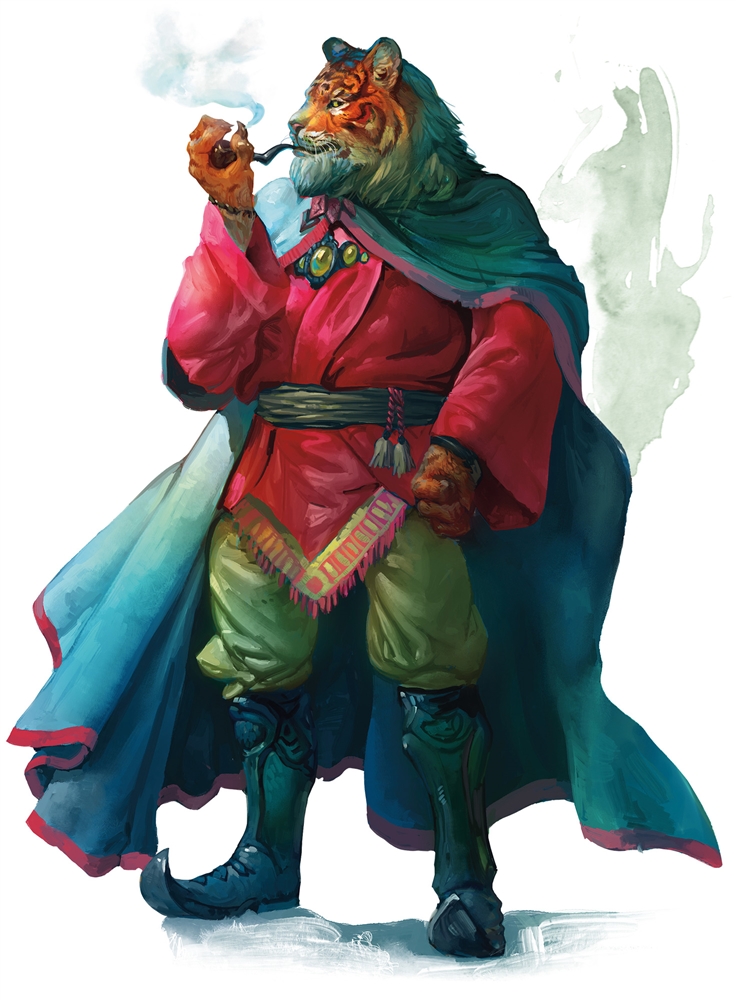
Appearance: Dresses in a sharp suit and smokes a slim pipe. Black hair with a streak of silver that hangs foppishly over his brow.
Roleplaying:
- Speaks concisely.
- Arches an eyebrow inquisitively.
- Puffs on his pipe thoughtfully.
Background:
- Private eye who runs the Tiger’s Eye, located towards the western end of Trollskull Alley (DH p. 32).
- Actually a rakshasa named Valantajar; uses disguise self before speaking to visitors or emerging into public (DC 18 on Intelligence (Investigation) check to detect). The spells lasts for 1 hour, so he notably excuses himself at such intervals.
- Investigations: 50 gp sufficient for most investigations, but if it’s a significant task (investigating major factions, for example), Trench might require a service in payment, such as slaying enemies that are hunting it, posting advertisements for its business in their tavern, or keeping tabs on someone he’s been hired to spy on.
Stats: Rakshasa (MM p. 257)
RISHAAL THE PAGE-TURNER

Appearance: Gold dragonborn. Pince-nez glasses at the end of his snout.
Roleplaying:
- Bookish, but with a deep, gravelly voice.
- Taps fingers of his hands together nervously.
- Small curls of smoke emerge from his nostrils when happy.
Background:
- Owns the Book Wyrm’s Treasure at the western end of Trollskull Alley (DH p. 33).
- Knew Lif, the former owner of Trollskull Manor, and arranged for the sale of his modest library after he passed.
Stats: Mage (MM p. 347)
- Neutral
- Racial Traits: Exhale 15-ft. cone of fire once per rest (2d6 fire damage; DC 10 Dexterity save for half damage). Resistance to fire.
- Languages: Common, Draconic, Dwarvish, Elvish
HAMMOND KRADDOC
Appearance: A rather portly gentleman dressed in a fine silk doublet with a fashionable dress coat of displacer beast fur. He has a thin moustache that angles down sharply, only to gently curl back up by the slightest of degrees.
- Always accompanied by Jinny (NG female tiefling commoner) who wears spectacles and silently records notes and conversations in a small book as Hammond speaks.
Roleplaying Notes:
- Sniffs at a perfumed handkerchief.
- Doesn’t like adventurers, but does like their coin.
- Warms up considerably (dropping most of his effete affectations) if engaged knowledgably by a fellow aficionado of wine and liqueurs.
Background:
- He was once the owner of the Elysium Fields, a vineyard south of Waterdeep. The Elysium Fields were destroyed when a group of adventurers ended up fighting a black dragon in the middle of them. Even if he could have rebuilt, the dragon’s acidic breath had permanently altered the Ph balance of the soil.
- He came to Waterdeep and joined the Vintners’, Distillers’, and Brewers’ Guild, using his vast knowledge of viticulture and personal connections to “improve the general fare of consumption in the city of splendors.”
- Gave Lord Dagult large bribes to cover up a scandal involving contaminated liquor in the Dock Ward (see Lord Dagult’s Papers).
Key Info:
- Representative of the Vintners’, Distillers’, and Brewers’ Guild.
- His guild offers a wide range of plans for a new establishment’s base selection of liquor and beer (ranging from 50 gp for a few very common selections all the way to 1,000 gp or more for a truly exotic selection).
Stats: N male Illuskan human commoner (MM p. 345)
BROXLEY FAIRKETTLE
Appearance: A laid-back halfing with mutton chops and bushy eyebrows.
Roleplaying Notes:
- Strongly urges membership in the Fellowship of Innkeepers’ to “avoid further harassment.”
- Relates everything back to the lamentable burdens of being a father of nine.
- Scratches his cheek thoughtfully.
Background:
- Broxley came to Waterdeep as a refugee when he was just a wee young hin. His father and mother had fled Secomber when it was overrun by the Urshani hobgoblins in the 1470’s.
- Broxley started as a scuttle-boy for the local taverns. He eventually worked his way up through the kitchens until he finally came to own a tavern of his own, the Barefoot Boards (which is scaled for and caters almost exclusively to halflings).
- Broxley often supported other tavern owners in the area (many of whom he had worked with or for over the years), and he was elected as the new North Ward representative of the Fellowship of Innkeepers’ a few years back.
Key Info:
- North Ward representative of the Fellowship of Innkeepers’. (Inns and taverns are few and far between in the North Ward, so he makes frequent visits.)
- Has long believed Trollskull Manor to be haunted.
Stats: LG male strongheart halfling commoner (MM p. 345)
ULKORIA STONEMARROW
Appearance: A female dwarf whose face has been frozen in a terrible, almost horrifying rictus.
- Never seen without her shield guardian (MM p. 271) nearby.
Roleplaying Notes:
- A permanent scowl inflicted by some unknown cause.
- But incredibly friendly and personable; like everyone’s favorite grandmother.
- Occasionally gets a distant look in her eyes, waggles her fingers, and will murmur something like, “That’s better.” under her breath. (It’s unclear if she’s pulling people’s legs with this routine.)
Background:
- Nicknamed the “Gargoyle” due to the horrible scowl frozen on her face. Frightens children and adults alike.
- No one knows where she lives, but it’s believed to be underground, possibly a cellar or a dungeon under one of the city’s oldest estates. (She uses teleport spells to enter and leave her home.)
- Once owned Trollskull Manor. She sold it to a family of shield dwarves who fell on hard times and sold it to a woman who made it into an orphanage. The woman, Arissa Mirthkettle, turned out to be a hag who was cooking and eating the children. It was then abandoned for many years before being acquired by a half-elf named Lif. Lif, for his part, was killed in a terrible accident when one of the support beams on his ale casks broke and collapsed on top of him.
Key Info:
- Used to own Trollskull Manor. Hopes the new owners make something good of it.
- Charges 300 gp for castings of glyphs of warding.
Stats: NG female shield dwarf archmage (MM p. 342)
MATTRIM “THREESTRINGS” MEREG
Appearance: Lanky brown hair hangs down around a face more plain than handsome. He wears gaudy clothes of purple and green, and carries a badly scarred lute that only has three strings left to its name.
Roleplaying Notes:
- Talks about how difficult it is to play [insert song name] on just three strings!
- A goofy, lop-sided smile.
- Breaks into song (and it really is quite good).
Background:
- Plays a lute that only has three strings remaining.
- Hides his true musical skills to maintain a low profile.
Key Info:
- A Harper spy who uses his busking gigs to cover his intelligence-gathering operations.
- Works with Cal’al Claddani, a half-drow Harper agent who works in the Flagon and the Dragon in Skullport.
- Knows about a Harper hideout called Dalagor’s Fortress, overseen by a dragonborn mage named Felrax, in the uppermost level of Skullport.
- Has befriended Bonnie the Doppelganger and wants to help her and her gang settle into the city.
Stats: LG male Illluskan human bard (DH p. 195)
JALESTER SILVERMANE
Appearance: A middle-aged man with thinning brown hair. Wears a loose doublet and pants of dark silver-grey. A lean, gaunt strength.
Roleplaying Notes:
- Lonely (after the death of his boyfriend) and looking for love.
Background:
- Hails from Cormyr, where he was a member of the Steel Shadows mercenary company.
- Left the Dales with several members of the company, including his boyfriend, Faerrel Dunblade, and came to Waterdeep.
- Faerral and Jalester befriended Elminster, who brought them to the attention of Laeral Silverhand.
- Faerral Dunblade, was killed in a street fight last year.
Key Info:
- Captain of the City Watch.
- Secret agent of the Lords’ Alliance who reports directly to Open Lord Laeral Silverhand.
- Charged with spying on adventurers to determine whether they can aid or will imperil the city.
- Can get the location of Xanathar’s Lair from Laeral Silverhand.
Stats: DH p. 205
YAGRA STONEFIST
Appearance: Seven-foot-tall half-orc with purplish-gray skin, a tousled mop of black hair, and shapely tusks to either side of her mouth. She wears well-kept leather armor and has a simple sword strapped to her side. She wears a large pendant of red jade, seared with the winged-serpent sigil of the Zhentarim.
Roleplaying Notes:
- Likes challenging adventurers to arm wrestle.
- Cracks her knuckles.
- Incredibly hostile towards slavers and Xanatharians.
Background:
- Yagra was rescued from slavers by the Doom Raiders. She and Ziraj the Hunter dated briefly, but it didn’t really work out. By the time they broke up, however, the Doom Raiders had joined the Black Network and moved to Waterdeep to take over the local Zhentarim.
Key Info:
- Zhentarim mercenary working for the Doom Raiders.
- Intermittently works as Davil Starsong’s bodyguard.
- Knows a “back door” into Xanathar’s Lair.
Stats: N female half-orc thug (MM p. 390)
- 1/long rest, when reduced to 0 hit points, drops to 1 hit point instead.
- Darkvision 60 ft.
- Languages: Common, Orc

